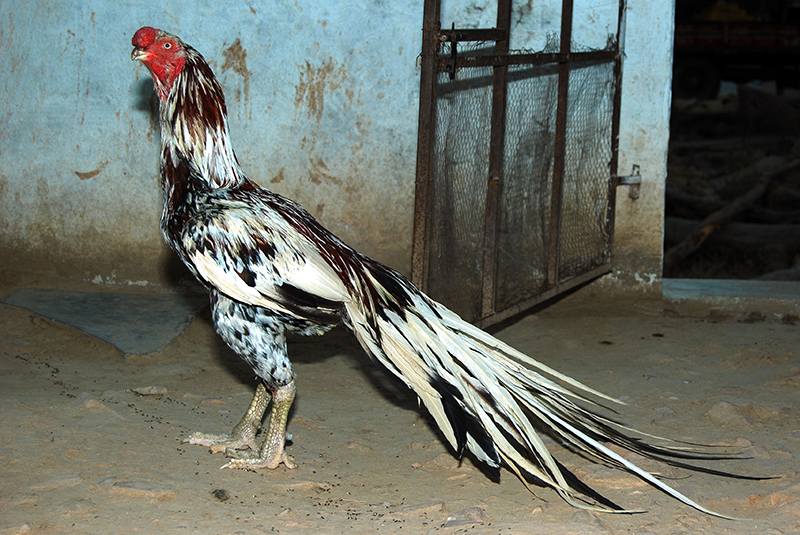Aseel Chicken
The Aseel originates from India and has been known for around 2,000 years. The Aseel was the forbear of the Cornish. In Arabic, Aseel, means “high born” which coincides the temperament of the Aseel. In India, the Aseel are bred for cock fights because of the aggressive nature.
Characteristics
Anyone familiar with the modern exhibition Cornish; short in leg, very broad in chest
and shoulders, hard  feathered, with narrow stern, has seen a replica of the Aseel. The Aseel has a well-muscled
body, yellow curved beak, and has yellow or white skin. The Aseel has broad, prominent
shoulders, wide hips; narrow stern, but "thick and strong in hand at root of tail,"
this latter being a great indication of strength; full, broad, heavily fleshed breast;
thick and muscular thighs. It has small head appendages with pea or triple shaped
combs. The birds have small intestinal tubes, short, hard feathered and are plump
and firm in the head. They are classed as an Asian hard feather. In fact, an Aseel
with long, soft feathers, or one that isn't hard muscled and "as heavy as lead," is
not typical and of no special value. The females lay eggs with tinted shells, and
are sitters; however, the average number of eggs laid per year is smaller compared
to other breeds. The Aseel lay eggs seasonally. Hens are known to go broody occasionally.
When hatched, chicks tend to start fighting each other.
feathered, with narrow stern, has seen a replica of the Aseel. The Aseel has a well-muscled
body, yellow curved beak, and has yellow or white skin. The Aseel has broad, prominent
shoulders, wide hips; narrow stern, but "thick and strong in hand at root of tail,"
this latter being a great indication of strength; full, broad, heavily fleshed breast;
thick and muscular thighs. It has small head appendages with pea or triple shaped
combs. The birds have small intestinal tubes, short, hard feathered and are plump
and firm in the head. They are classed as an Asian hard feather. In fact, an Aseel
with long, soft feathers, or one that isn't hard muscled and "as heavy as lead," is
not typical and of no special value. The females lay eggs with tinted shells, and
are sitters; however, the average number of eggs laid per year is smaller compared
to other breeds. The Aseel lay eggs seasonally. Hens are known to go broody occasionally.
When hatched, chicks tend to start fighting each other.
Varieties
Black, White, Duckwing, Red Spangled, Pyle, etc.
Standard Weights
Cock: 6 lbs
Hen: 5 lbs
Uses
The Aseel are used primarily for meat and ornamental reasons.
References
Ekarius, Carol. "Chickens: Aseel."
Pocketful of Poultry: Chickens, Ducks, Geese, Turkeys. North Adams, MA: Storey Pub., 2007. 26-27. Print.
Lewis, Celia. "Breed Profiles: Aseel, Asil or Reza Asil."
The Illustrated Guide to Chickens: How to Choose Them, How to Keep Them. New York: Skyhorse Pub., 2011. 48-49. Print.
Platt, Frank L. 1925. All Breeds of Poultry, Origin: History: Description, Mating and Characteristics. American Poultry Journal. Chicago.
